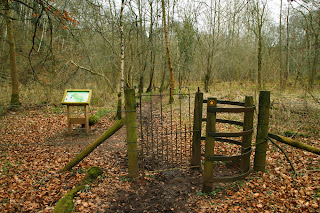Wreay Woods, situated approximately four miles from Carlisle city centre, Cumbria, represents a fragment of the wild wood. Knareled trees reaching skyward with an ancient presence, as magic as any fairytale but the wild wood is real. Or should I say was real, we have lost much of it. The woods brim with flora and the fallen limbs of mighty trees provide dead wood that is hugely important to the rest of the wildlife. You can walk the course of the River Pettrel that runs through the reserve. The mix of semi-natural woodland and flowing water running through it offers further habitats for a wide range of species and the banks become lush with lichens and mosses. The river has cut out a deep gorge in the sand stone that formed the sloping sides of the wood. As the path follows the river the steep wooded slopes on both sides provides shelter within the gorge. What could be on the river? I'd hoped I'd get dealt a good hand that day.
I entered Carlisle by train at 8.15am. I toyed with the idea of taking my bike on the train but I was in no rush, and besides I prefer walking. I've found walking much easier than knowing what to do with a bike when I'm out wildlife watching because I find myself constantly stopping or detouring. Or I just want more freedom to go where bikes can't.
I noted the urban sprawl dissipate to farmland as I walked the long road to the reserve just out of Carlisle. The change was gradual but apparent. It makes me think about the way we live simply from observing this gradual change. I wondered to myself how we ever became this way, living entombed in a cold, chaotic, concrete world. How did the human race ever come to this desperate place. New developments of properties that I passed on my walk were void of personality, clinical by creation. The same housing developments we see over and over again, one simply a replica of the next. They are little lego houses. Yet this force seems unstoppable, the need to build more, ever encroaching and ever encasing us. A black tide. We are a beautiful species. We are capable of such greatness. We are all so much more than this but the developments go on and our world grows cold. Where is your heart? Where is your soul? Not in this place. Not at this time. Not any more.
Having made it off the ring road towards the entrance here is a pictorial account of my journey....
A Grey Wagtail put in a welcome appearance. The dippers on this stretch of river were beginning to start nesting. I watched as they both flew up and down the river gathering straw for nesting material and flying into a small hole underneath the bridge that was obviously a suitably roomy nest site even though, a little like with bats roosting, it doesn't always look it.....
....underpass just off the ring road....
.....Taking a wander through a wood on the slopes leading to the nature reserve I found Wild Primrose....
....some of the trees were spectacular in their twisted age being a remnant of the ancient wood.....
....On entering Wreay Woods the wood itself was very quiet.
A Jay called its horse call and Greater Spotted Woodpeckers were drumming.
The occasional Wren burst into song.
I caught sight of a Nuthatch briefly. I didn't go that long without seeing a Dippers or a Grey Wagtail on most bends as I followed the river.
After making my way through the reserve I exited the boundary's of the site. The path continued but from here on in things were about to get allot more tropical....
It looked like they had a serious problem with rhododendron. Inside of the reserve management has obviously been good at keeping this invasive species under control.
I look forward to coming back in the summer. Unfortunately a Kingfisher was not on the list of species I saw today. Doubtless I will return to try my hand again at looking for them as this is a very nice stretch of river and I know they are here! On my way back it remained just as quiet. I did however observe where one pair of grey wagtails were attempting a nest for this year. Oh, and one buzzard over the motorway. Homeward bound I think.




















